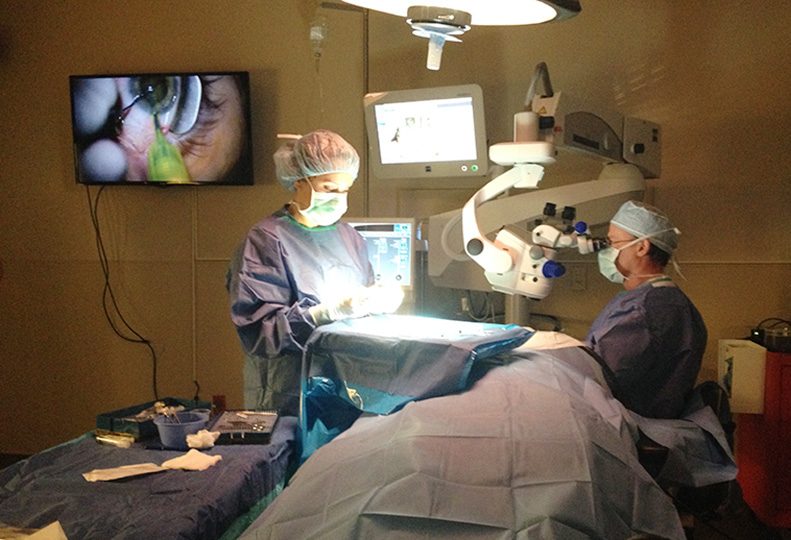
Home » Laser technology enhances cataract surgery, doctors say
Laser technology enhances cataract surgery, doctors say
Device is said to make more precise incisions

May 7, 2015
Two doctors at a Spokane Valley eye-care clinic say a laser device now aids them in the process of performing cataract surgery.
Drs. Mark Kontos and Christopher Sturbaum of Empire Eye Physicians have been using the $425,000 Catalys femto-second laser machine for almost two years. The precision and exactness of the laser gives them an advantage in removing cataracts, they say.
The laser “fragments” and “softens” the eye, allowing the cataract to be removed in a gentler and easier manner, Sturbaum says.
That’s a benefit to the patient because it enables them to heal quicker and suffer fewer complications, he says.
A cataract is the clouding of the lens of the eye that can impair vision. The National Eye Institute estimates that half of all Americans 65 and older suffer from cataracts. Cataracts can vary from extremely mild cases to a worst-case scenario of complete blindness in one or both eyes, Sturbaum says
Incisions have to be made in the eye, either with the surgeon’s knife or with a laser, to open the eye to remove the cataract. Sometimes, the cataracts can be soft and removed easily; however, sometimes they can harden over time and prove challenging to remove manually, Sturbaum says.
“It was absolutely fantastic,” says Virginia Pinson, who had cataract surgery at Empire Eye Physicians in January. “There weren’t any problems at all. It has made such a difference in my life. I can put makeup on without glasses. It’s just crazy.”
Medicare’s Center for Disease Control estimates that 3 million cataract surgeries are performed each year in the U.S. The amount spent by the U.S. federal government to treat cataracts through Medicare is $4 billion, say Medicare’s statistics. Sturbaum says it’s the most common surgery performed in the U.S. today. He estimates he has performed 10,000 of them since doing his first in 1995. Kontos has been at Empire Eye Physicians since 1993, he says.
Cataracts surgery has a 98 percent success rate, says Medicare’s Center for Disease Control, and postoperative complications are rare. Despite the high success rate, Kontos and Sturbaum believe the laser gives them the opportunity to perform a higher-quality surgery. While the overall success rate is high, initial complications, such as fluid leaking from incisions, isn’t out of the ordinary, Kontos says.
“The laser pre-cuts the cataract like sliced bread,” says Sturbaum. The patient rests on his or her back underneath what looks like an oversized department store countertop. Resting below the box-shaped device is the laser, which makes optical incisions more precise than anything either men have ever done, they say. Both doctors say having the laser has shaved 10 to 15 minutes off what is on average a 25- to 30-minute surgery.
Kontos and Sturbaum have used the Catalys femto-second laser 450 times since setting it up in their clinic at 1414 N. Houk Road 22 months ago, says Debra Jamison, Empire Eye Physicians supervisor of Laser Institute.
“We can’t achieve manually what the laser can do, it’s just not possible,” Kontos says.
While cataract surgery typically is covered by insurance, most payers currently don’t cover the laser procedure, Sturbaum says. The Empire Eye Physicians office charges $1,195 per eye for use of the laser.
“I believe it’s just a matter of time before laser-assisted surgery will become standard,” Sturbaum says.
Pinson, who is 69, says she had worn glasses since she was 7 years old. She only wears them now for reading.
“I have recommended the doctors to so many friends of mine,” Pinson says. “It’s a fantastic thing to go through. I would highly recommend it to anyone who needs it.”
Empire Eye Physicians was founded more than six decades ago by Dr. Smith Fuller Hogsett who was later joined in the practice with his son, Dr. Smith Hogsett, says a Dec. 22, 1988 story which appeared in the former Spokane Chronicle newspaper. Both Drs. Kontos and Sturbaum own Empire Eye Physicians, which employs 21 people and performs seven different forms of eye surgeries and procedures, Jamison says.
Latest News Special Report Health Care
Related Articles



